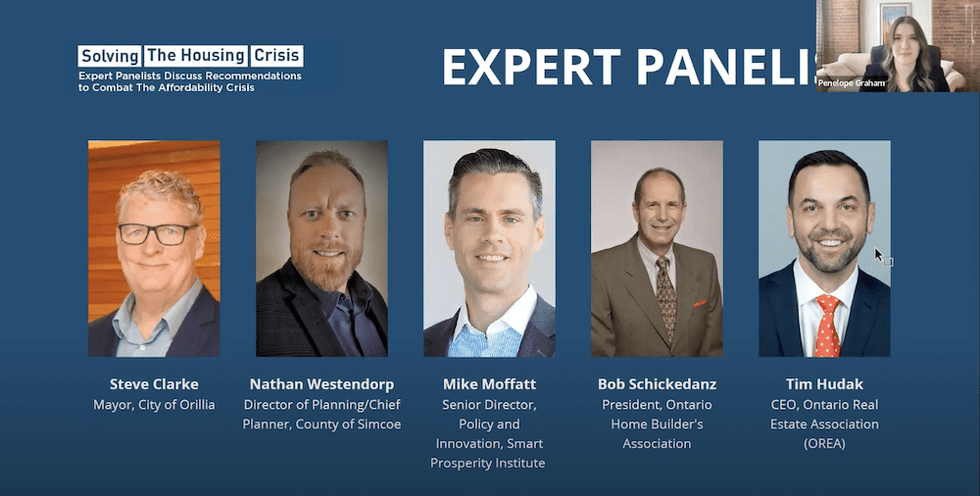Last Thursday, May 12, the Barrie and District Association of Realtors, in partnership with STOREYS, presented Solving The Housing Crisis, a discussion among expert industry panelists examining some of the top challenges facing housing supply creation.

Panelists included a number of housing authorities with specific expertise at the local, regional, provincial, and national levels, and was moderated by STOREYS Managing Editor Penelope Graham:
- Tim Hudak, CEO of the Ontario Real Estate Association (OREA)
- Steve Clarke, Mayor of Orillia
- Nathan Westendorp, Director of Planning/Chief Planner County of Simcoe
- Mike Moffatt, Senior Director, Policy, and Innovation Smart Prosperity Institute
- Bob Schikedanz, President, Ontario Home Builder’s Association
Some of the most hotly discussed topics centered on the implementation of housing recommendations made in the provincial budget, as well as those brought forth by the Housing Affordability Task Force.
When asked about how standardized province-wide zoning requirements (such as minimum lot sizes and heights, maximum building setbacks, for example) would help streamline the land use approval and planning systems already in place, Schikedanz said that while it’s a good “aspirational goal”, he foresees roadblocks among the existing municipal systems in effectively putting it into place.
“On the surface, that would be pretty good, if we could standardize everything. But the 444 municipalities in the province all have diverging zoning bylaws… it’s a challenge at best to get that done,” he stated during the panel. “To have a province wide one, it’s a great goal, but I fear it could be bogged down by years and years of trying to find what the standard is. Perhaps we should pivot and focus our attention towards the processes we have to go through, to streamline a process and regularize a process in terms of, what are the steps? What are the expectations, what is the timing… create a data standard. If there’s bottlenecks, then we can look back and say, “Well, this isn’t working,’ and point our fingers and say, ‘Perhaps these should be updated.”
Countered Hudak, “You’ll see municipalities throw up artificial or outdated barriers to housing; there needs to be some kind of referee to step in on that matter.”
He pointed to a recent project in Toronto, where a seven-storey building -- that would have included affordable housing units -- was cancelled due to being in a slight shadow for part of the day, a move he calls “outrageous”.
The province’s recent budget promise to build 1.5M homes -- a pledge that has been since echoed by the provincial Liberals and NDP as part of their costed election platforms, was also a top point of discussion, as the panelists mulled over the logistics of actually delivering that level of supply on a the stated timeline.
“It’s a huge problem in terms of the logistics and just getting there considering there’s been, over the last 10 years we built in this province approximately 700,000 homes -- now we want to over double it, and the industry is near capacity," Schikedanz added. "We have to do a better job of attracting young people to the trades, we have to look at the immigration system to attract talent to this country that we need. We talk about infrastructure, we talk about zoning, and what I call entitlement -- all these pieces have to work in harmony.”
Moffat, meanwhile, pointed to inefficiencies in federal immigration programs that prevent the entry of newcomers with the skill sets needed to fill labour gaps.
READ: Canada Desperately Needs More Immigrants with Specialized Trade Skills as Shortage Looms
“I think we’re doing a great job of identifying all these different kinds of bottlenecks, but on the labour side, I think the federal government needs to be doing more. If we look at the last draw of the Federal Skills Trades Program, through express entry, I think we only had a couple of hundred people come in, which is unacceptable given the trades shortage.”
Other topics discussed included added infrastructure to new and rural communities, designating land use for development, as well as the implications of skyrocketing home prices for markets of all sizes.
You can watch the entire panel conversation here.





















